I've been craving an authentic cacio e pepe recipe ever since I moved back from Italy. So, I wanted to share my one-pot, foolproof cacio e pepe recipe with three ingredients that is ready in twenty minutes. This recipe is a throwback to my friendship with folks at a small restaurant in my neighborhood in Rome - a place that Anthony Bourdain loved. So you know it's time tested and delicious.
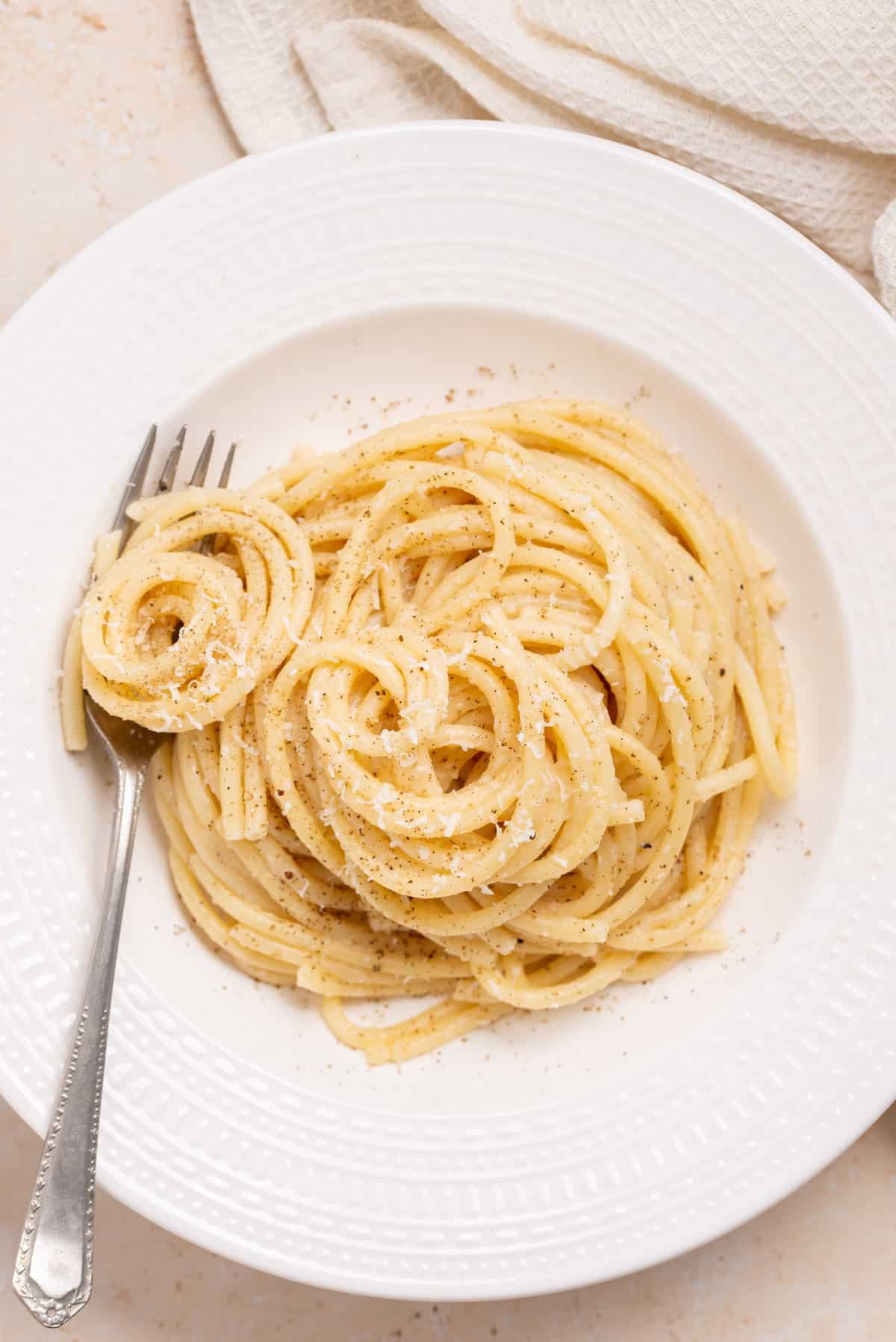
This post contains helpful tips and tricks! If you're in a rush, please use the "Jump to Recipe" below!
🍲 What is cacio e pepe?
Cacio e pepe literally means "cheese and pepper" in Italian (cacio, in the local dialect, literally refers to pecorino Romano, i.e. the pecorino of Rome). This is a simple Roman pasta (there's a tale that peasants invented this because they had no meat, but here we are). Move over, fettuccine Alfredo, the classic cheesy pasta is in town.
💭 Why you'll love this recipe
- Inspired by Anthony Bourdain's favorite cacio e pepe in Rome: This is a recipe I first learned to make when I lived in Rome, from Anthony Bourdain's favorite restaurant.
- Uses only three ingredients: Traditional and authentic cacio e pepe does not use butter or cream. True to that, this recipe uses just three ingredients.
- Comes together in under 30 minutes: This recipe is as quick as it's delicious, so it's perfect for a quick weeknight meal or your next date night!
📋 Ingredients & Notes
You need just three ingredients for this classic Roman pasta: pasta, pecorino, and pepper. I know it's hard to get the exact ingredients sometimes, so I've listed a few substitutions. But this recipe is made without butter, so read on!
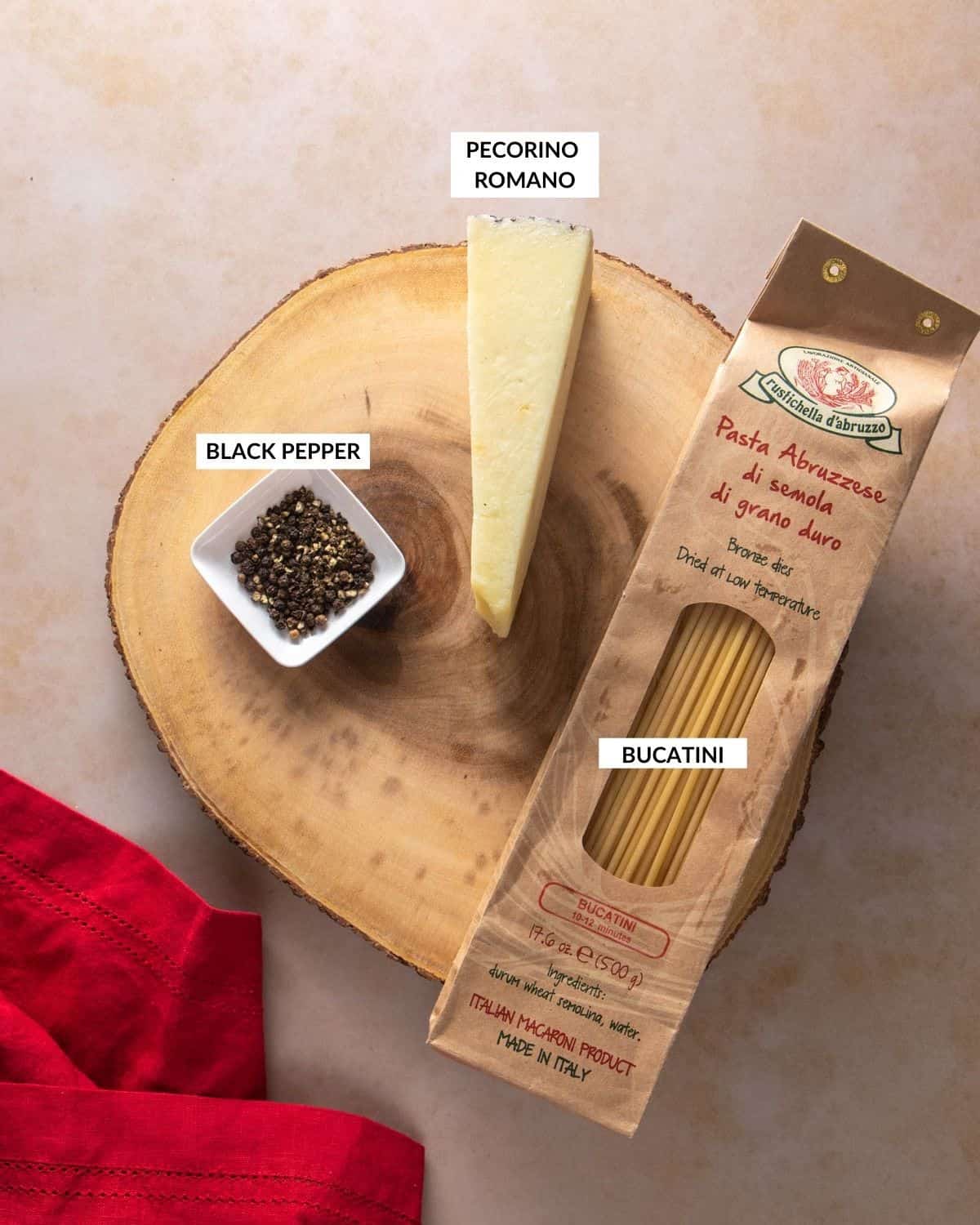
Notes:
- What kinds of pasta can you use? Traditionally, tonnarelli or bucatini. But, any thick pasta or spaghetti can work in a pinch too. The key is to get a tubular, long pasta to which the sauce can adhere to. Traditional tonnarelli is a little coarse, making it super delicious when you add cheese.
- What kinds of cheese do you need? The only cheese you'll need is pecorino Romano, the cheese native to that region. Try to get the sharpest pecorino Romano you can get your hands on and grate it fresh. If you can't find pecorino, especially vegetarian pecorino, you can use parmesan (but just note that the flavors will be slightly different since pecorino is sharper)
- Do you use cream? Only if you want my old Italian landlord to haunt you from his grave ... just kidding. But, seriously though - no cream or butter! Take the pasta water out when it's starchiest, i.e. right before draining. That's all you need to bind the pepper and cheese into gooey, saucy goodness. Using cream dilutes the sharpness of the cheese and it's also not necessary!
♨️ Make authentic bucatini cacio e pepe!
Cook the pasta to package directions using the right amount of water (a gallon of water for every 16 oz of pasta)
While pasta cooks, grate about 2 cups of Pecorino Romano (using the smallest hole on your grater). Set aside in a large bowl.
2 to 3 minutes before the pasta is done, heat a skillet on medium heat, and add a generous amount of freshly cracked pepper to toast it.
Use a ladle and scoop out some of the pasta water into the skillet with the pepper. The water will bubble, and turn somewhat white due to the starch (but this is good, because it'll help the cheese and pepper bind to your pasta!)
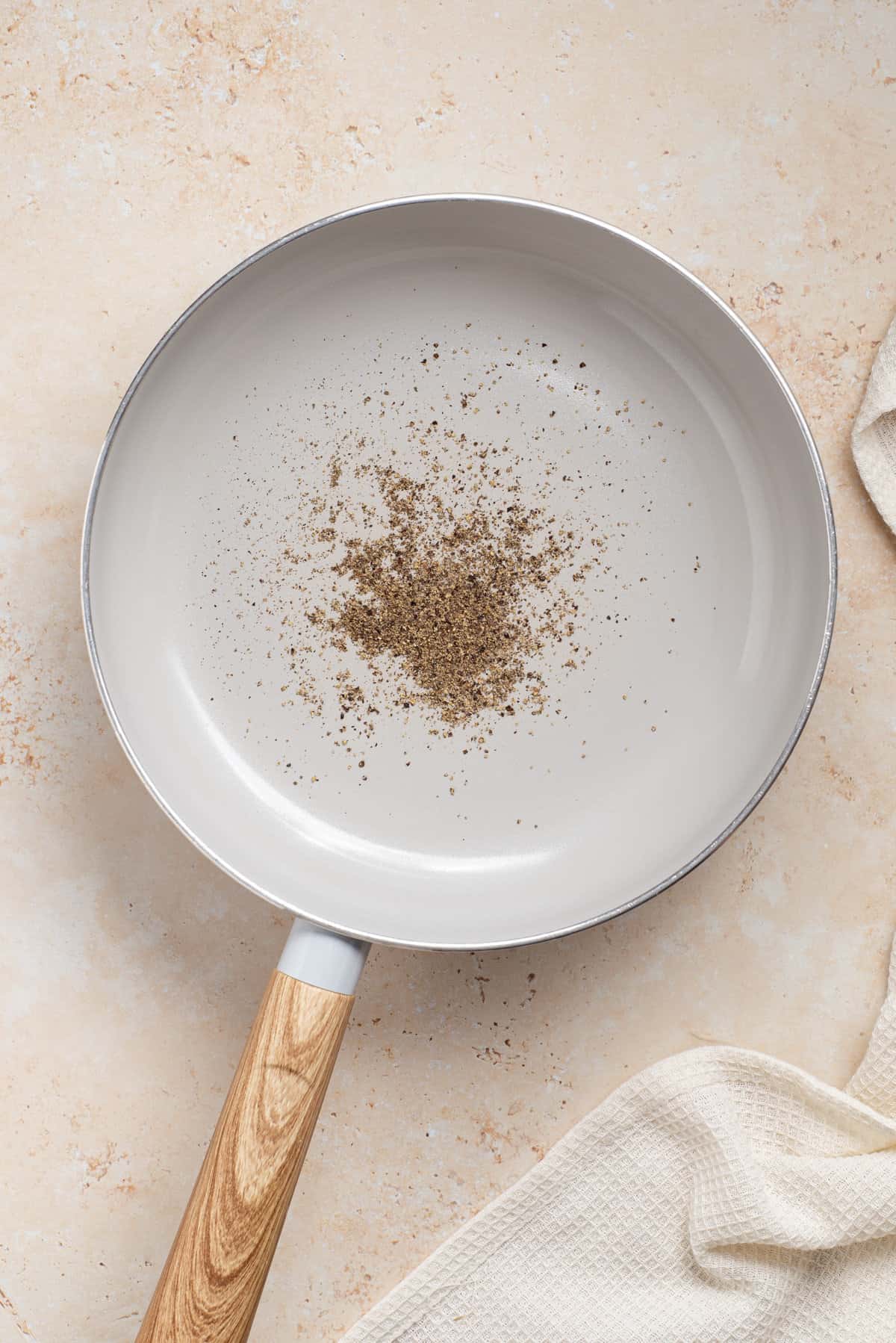
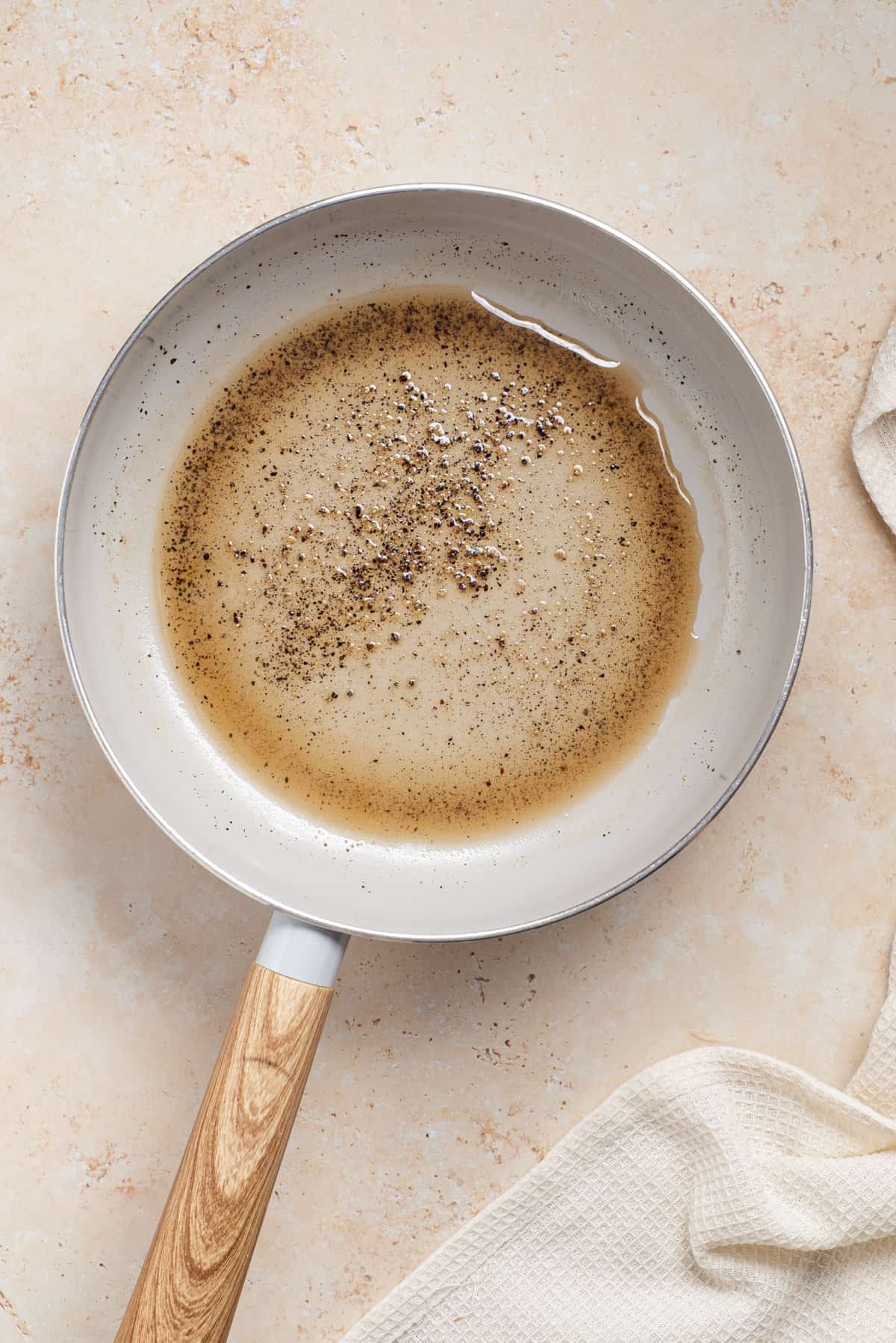
Pro Tip: Save a couple of tablespoons of hot pasta water in case you need to thin the sauce. Doing this right before the pasta is done cooking to get the water when it's starchiest, which, in turn, helps the cheese bind to the pasta.
Add a quarter cup of the pasta water to the bowl with the cheese, ideally one tablespoon at a time and whisk it together using a fork to create a thick paste. Add cautiously since you don't want it to get runny (but don't fret if it does, just add more cheese!)
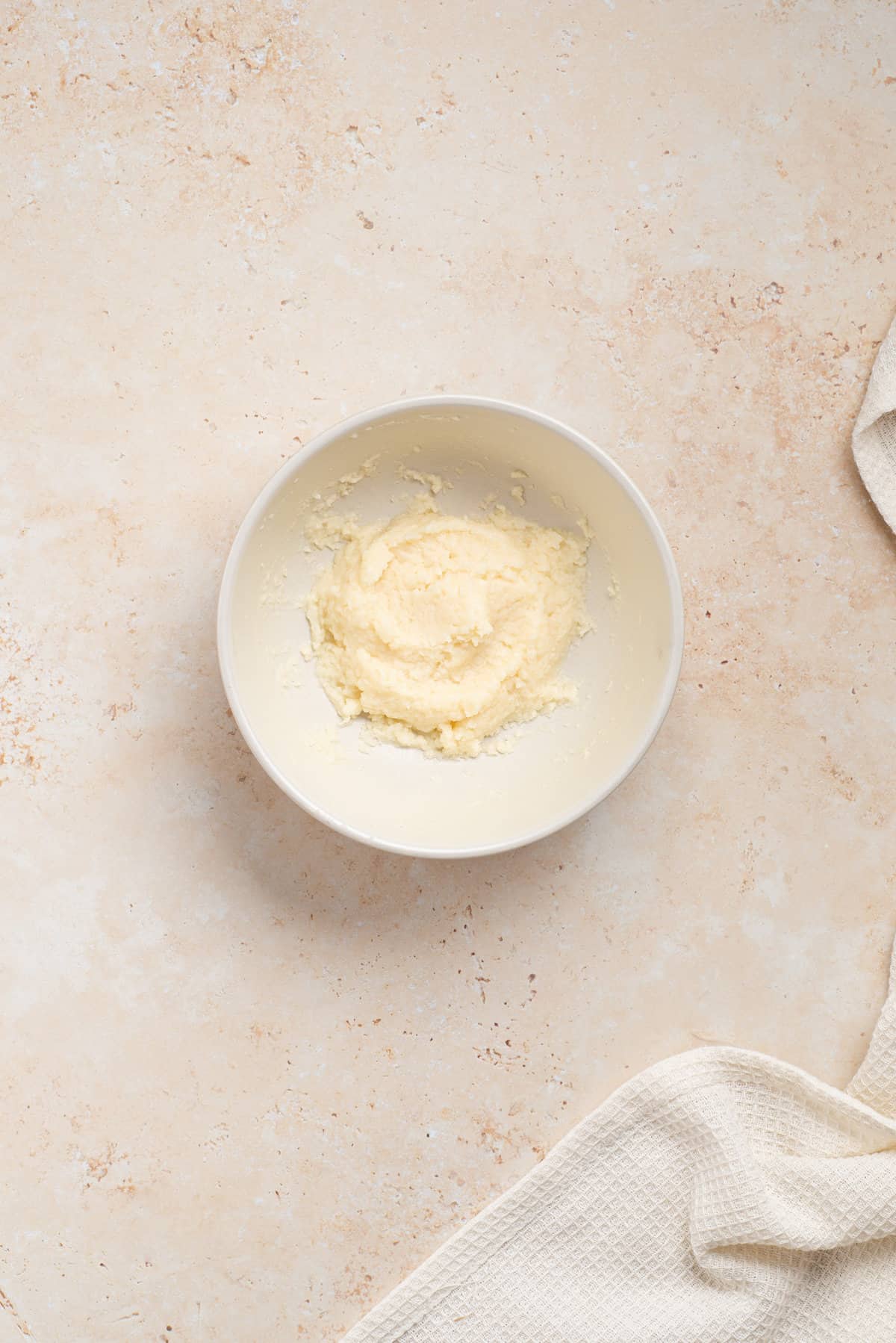
Unconventional, tech-savvy tip: Add cheese and pepper to a small food processor along with a tablespoon of cold water and pulse until it forms a "lumpy" mixture (or use a fork). Then, use hot water to dilute and bring it to the right saucy consistency.
Remove the pasta and add it to the skillet with the pepper and water, and toss to coat. The starchy pasta water is critical for binding with the cheese to create a smooth sauce!
Finally, turn the heat off, and add the cheesy paste to the skillet with the pasta. Toss evenly until combined and smooth (cheese should not be chunky).
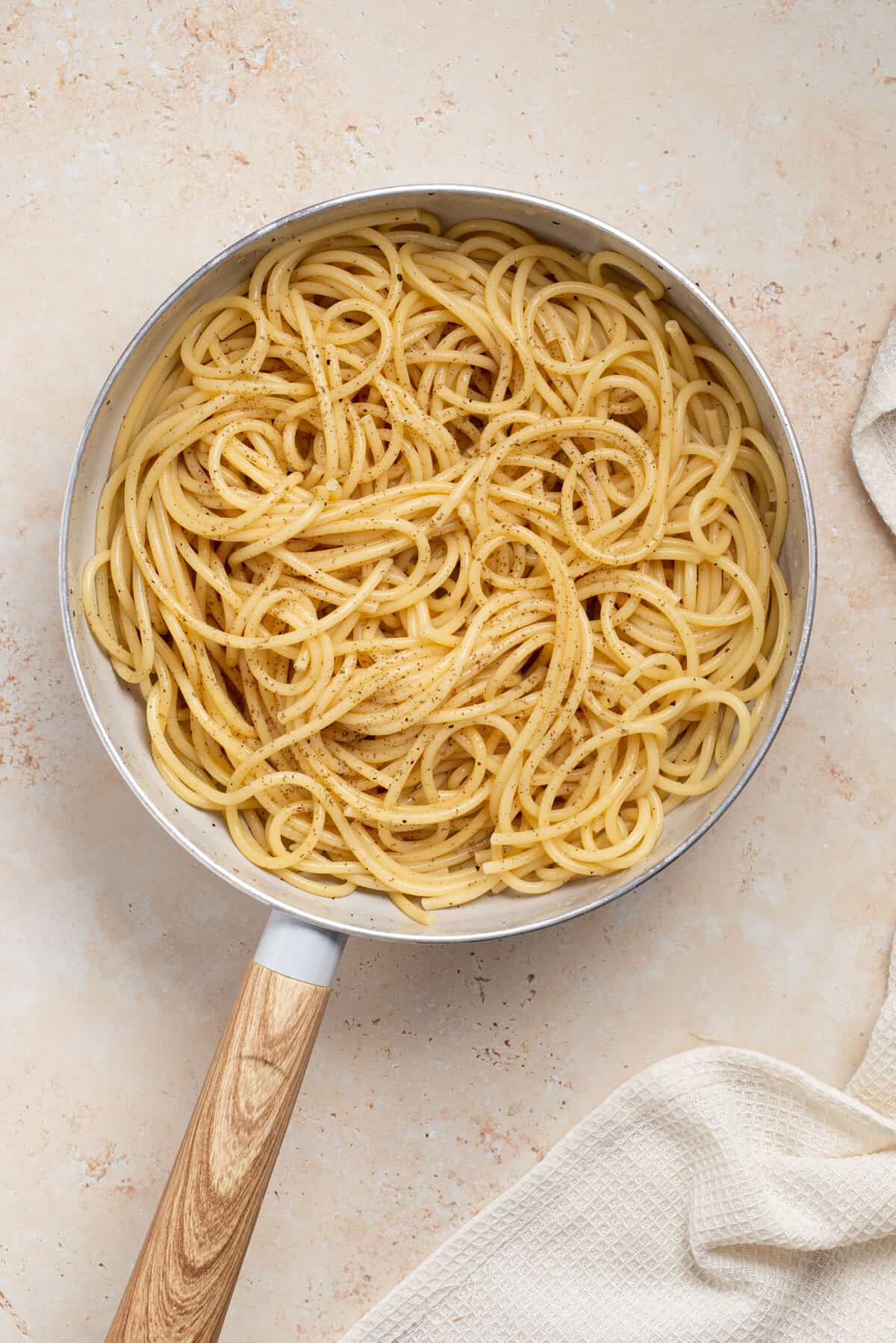
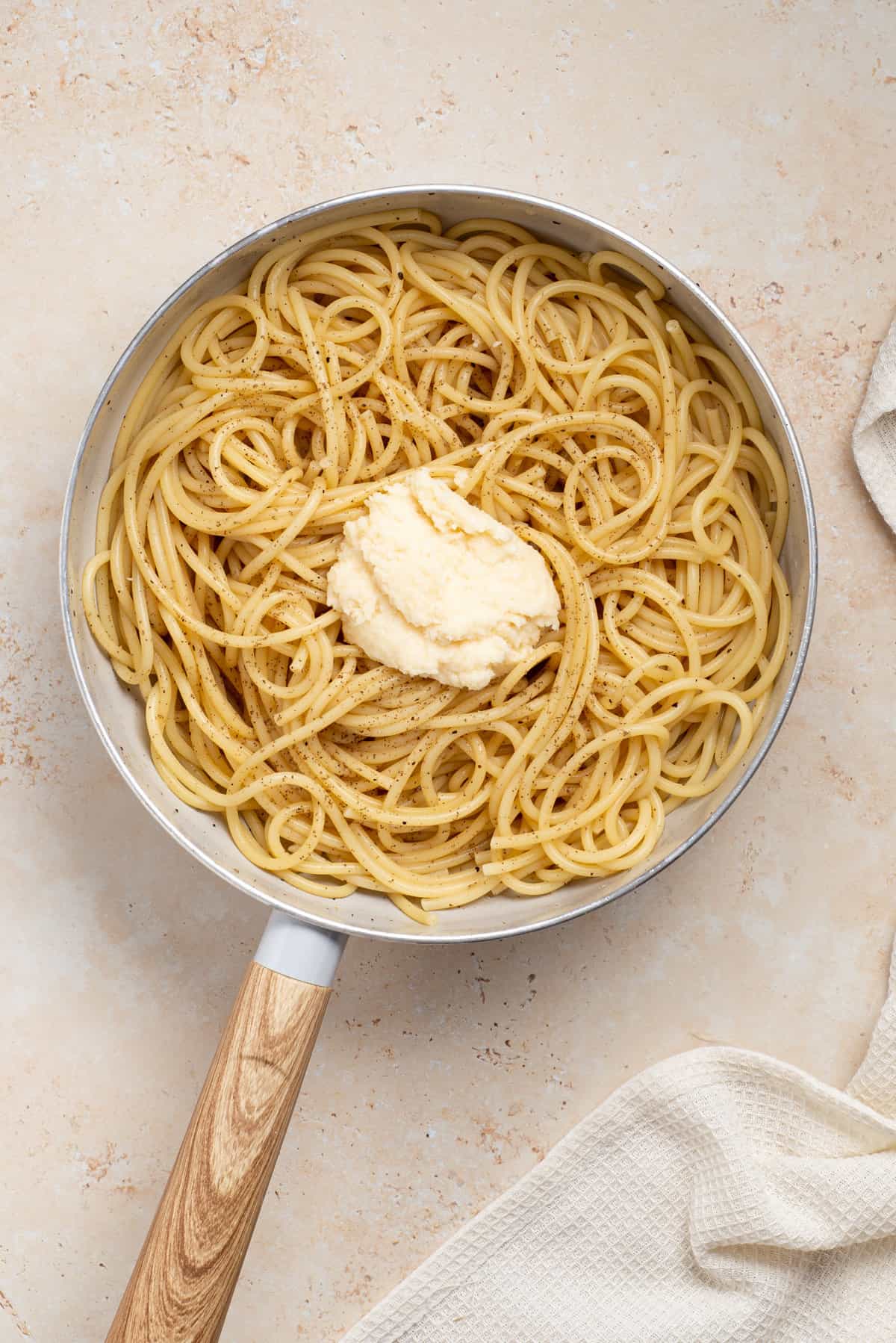
Serve hot with a grind of coarse black pepper and a sprinkle of cheese!
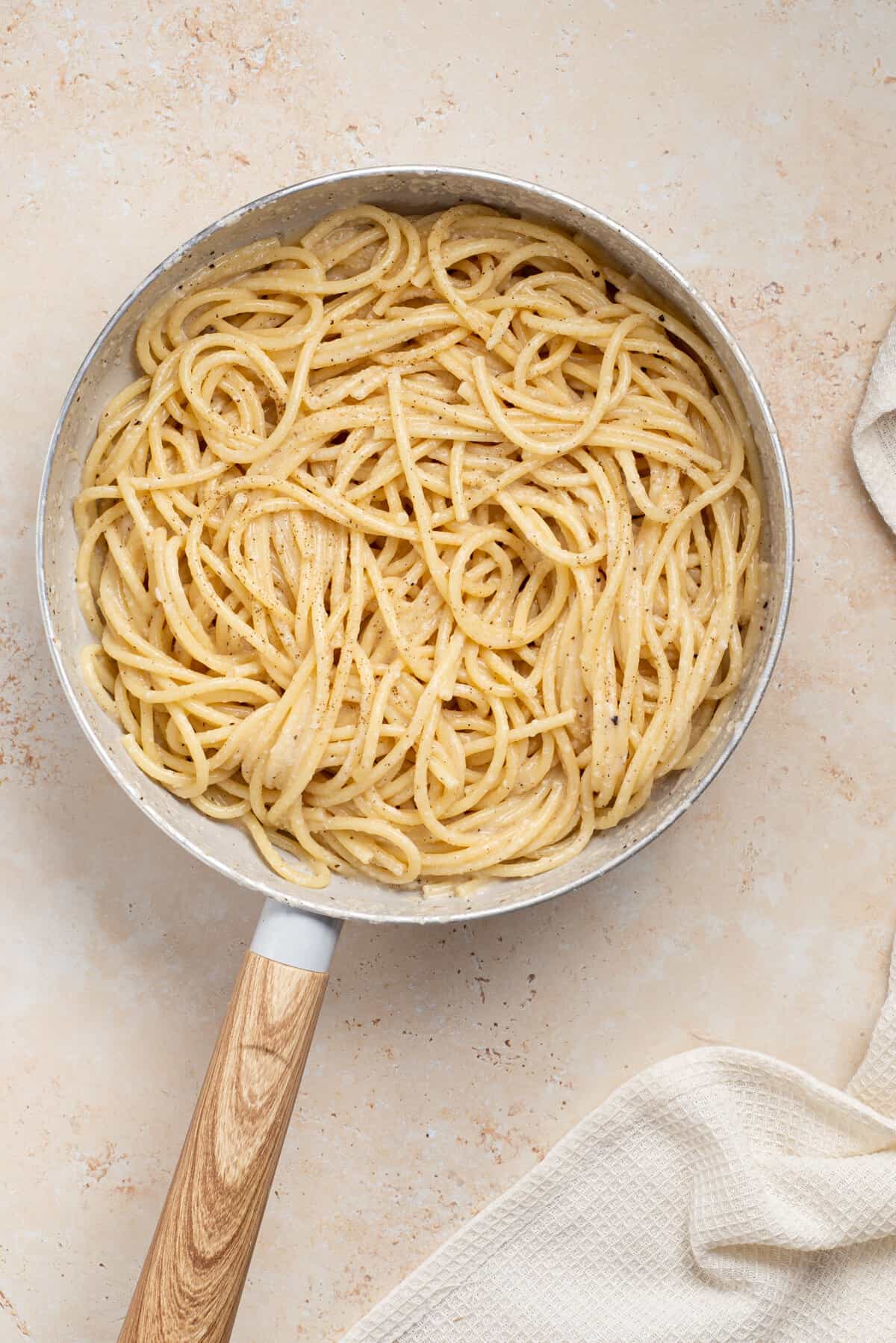
👩🏽🍳 Tips for authentic, foolproof cacio e pepe
- Use high quality cheese and grate it yourself . Get the best cheese you can afford, you won't regret it, and grate it yourself. Grated cheese often has potato starch or chemicals added to it, which makes it clump up and not melt. And you'll want to use the smallest hole for grating - it'll allow the cheese to melt uniformly into a consistent sauce!
- Use the right amount of water and drain at the right time. I typically don't have pasta water volumes, but the key to this recipe is thinning the cheese with the starchy pasta water. So, ensuring the right amount of starch to water is important. Use a gallon of water per package of pasta and reserve the pasta water 2 minutes before indicated al dente time (for instance, if package says 10 minutes, reserve water at 8 min mark)
- If mixing by hand, whisk, whisk, whisk - the cheese will melt. The process is fairly seamless with a food processor, but if you're mixing by hand, just keep whisking. Add cold water slowly to the grated cheese as you whisk (vs. adding it all at once). I suggest couple of tablespoons at a time. The cheese will appear clumpy at first but don't fret! The magic happens when you thin the sauce with hot water.
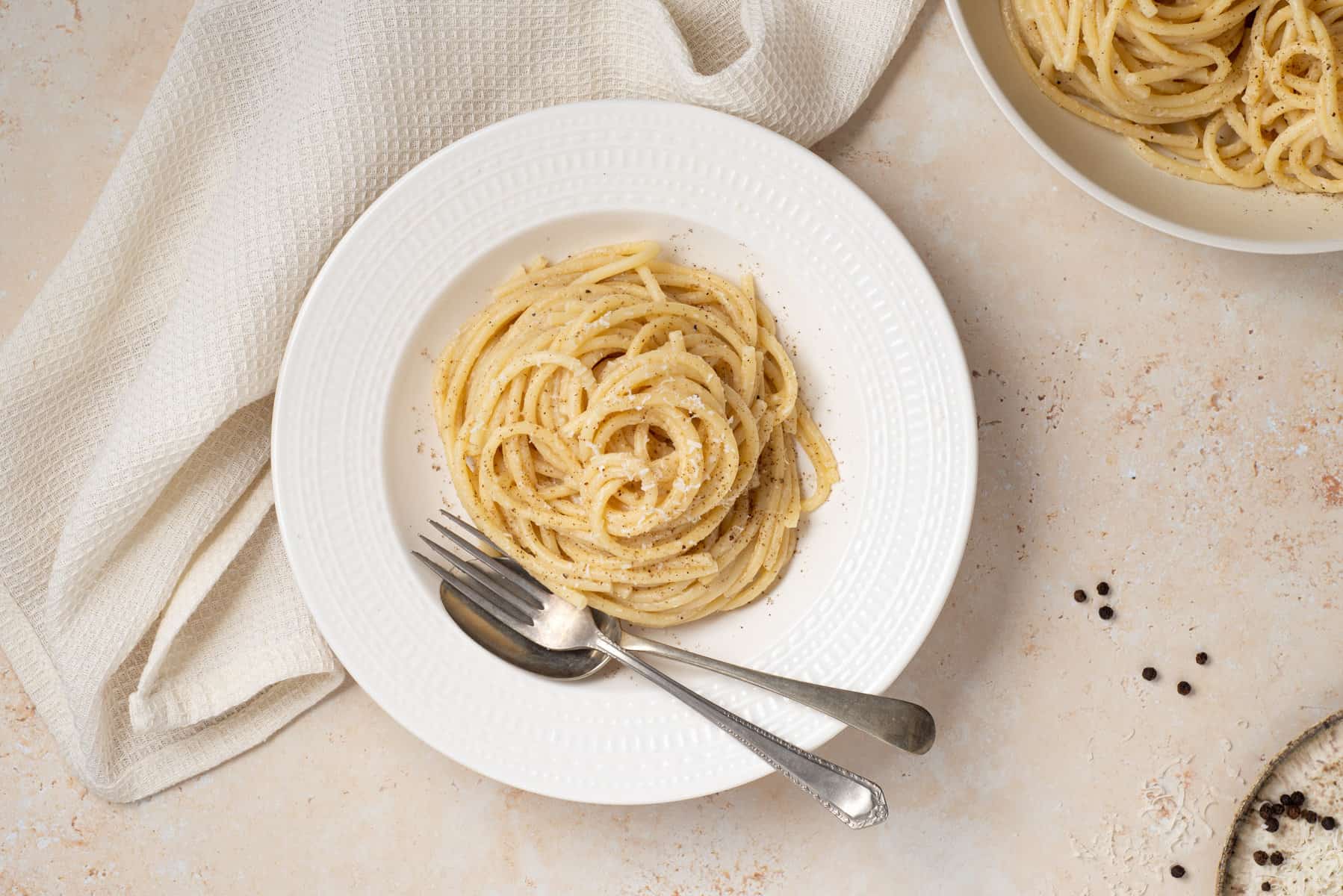
FAQs
This recipe does not use any butter or oil and that typically runs the risk of the cheese getting clumpy. The secret to avoiding that? Whisking or mixing it vigorously to ensure it forms a sauce.
Traditional recipes use only pecorino, but you can use parmigiana in a bind (or combine the two). Romano is a hard cheese and Italian Romano is named Pecorino.
Make sure to read the post above, but you basically ensure the right water to pasta ratio while cooking it, set aside pasta water with starch 2 minutes before that's done, whisk some Pecorino with cold water and then hot water to make a sauce, and layer in the sauce.
This is a personal choice! I don't like to overpower the dish with pepper so I use 2 teaspoons of freshly ground black pepper. You can increase the quantity or toast the pepper before adding it to the sauce in order to amplify the flavors!
🍷 Storage & serving suggestions
This recipe can easily be scaled down on the recipe card, and where possible, I suggest making it fresh. However, if you made extra, you can just store in the fridge, portioned out. Then, add a splash of water to the portion, and microwave for 1 minute, stirring once in between.
You can serve the cacio e pepe as a side to any meaty dishes if you have a carnivore in the family, or serve this as a main "primi" with a side salad (like my Brussels sprouts Caesar salad or my kale salad with pecorino and pepitas). It pairs quite neatly with a ton of stuff, but try to sneak in a glass of wine if you can - because nothing pairs better!
Personal Note: I didn't know when I lived in Rome that this was Anthony Bourdain’s favorite bowl of cacio e pepe. In fact, he loved the place so much that he wanted to keep it a secret. Small mom & pop restaurants would get flooded with positive reviews, grow an admirable following, but crumble under pressure. That said, I’m glad to report that this restaurant is still going strong, and the cacio e pepe is delectable. If you're heading to Rome and want to know, leave me a comment!
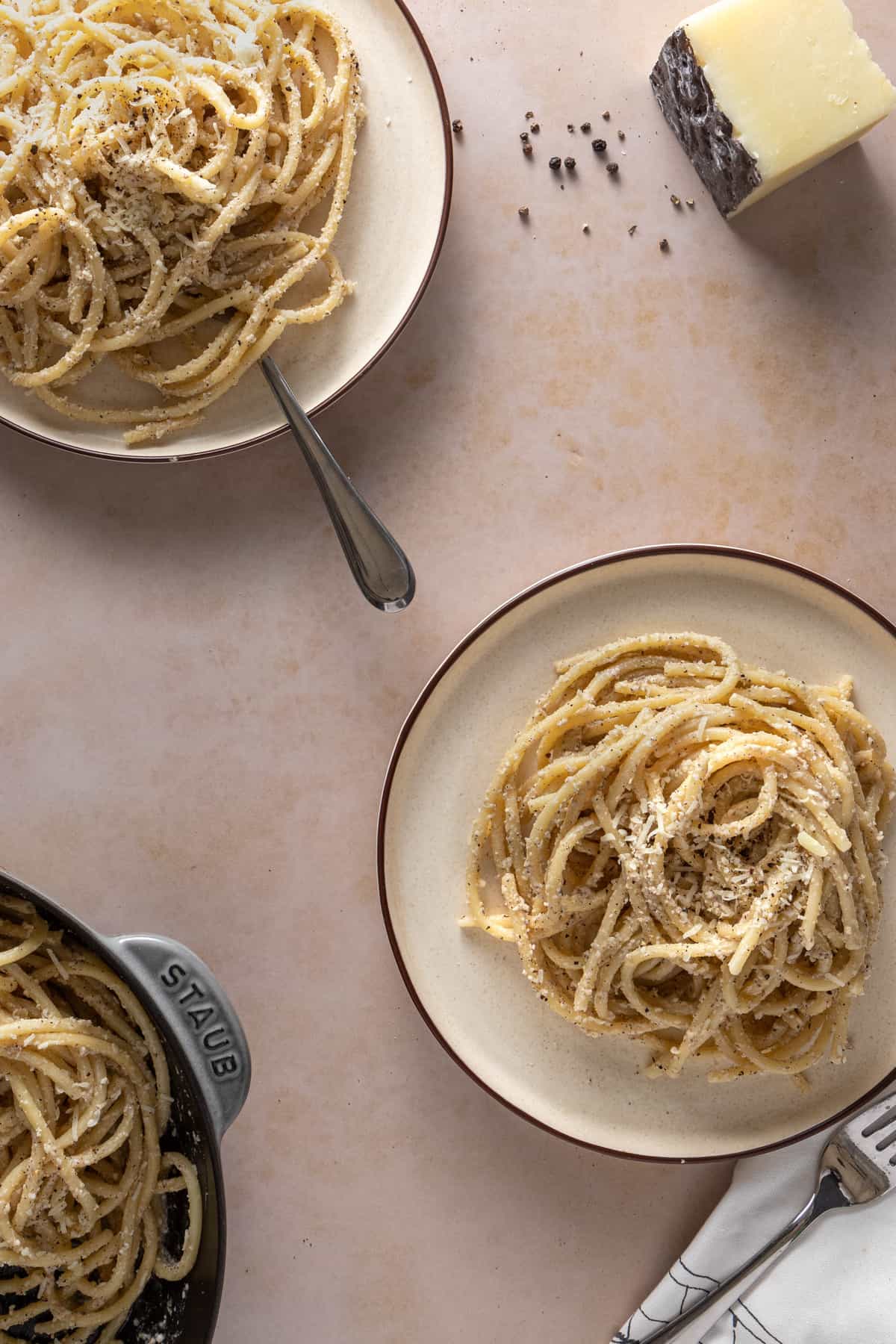
Check out other delicious Italian pasta recipes:
If you tried this recipe, don't forget to comment and rate! ⭐⭐⭐⭐⭐
📖 Recipe
Authentic Cacio e Pepe
Ingredients
- 10 oz bucatini pasta, see substitutions in post
- 2 teaspoons black pepper, freshly ground and coarse
- ¼ cup water, reserved from cooking pasta
- 2 cups Pecorino Romano, freshly grated, additional for garnish
Instructions
- Bring three quarters of a gallon of water to boil (roughly 2 liters, i.e. 10 cups of water) with salt. Add pasta and cook pasta slightly under the time mentioned on the package (typically about 8 to 9 minutes for al dente texture)
- As pasta cooks, grate Pecorino Romano (using the smallest hole on your grater). Set aside in a large bowl.
- Heat a skillet on medium heat, and add a generous amount of freshly cracked pepper to toast it.
- Use a ladle and scoop out some of the pasta water into the skillet with the pepper. The water will bubble, and turn somewhat white due to the starch (but this is good, because it'll help the cheese and pepper bind to your pasta!)
- Add a quarter cup of the pasta water to the bowl with the cheese, ideally one tablespoon at a time and whisk it together using a fork to create a thick paste. Add cautiously since you don't want it to get runny (but don't fret if it does, just add more cheese!) Unconventional, tech-savvy tip: Add the cheese and pepper to a food processor along with a tablespoon of cold water and pulse until forms a "lumpy" mixture (or use a fork). Then, use hot water to dilute and bring it to the right saucy consistency.
- Remove the pasta and add it to the skillet with the pepper and water, and toss to coat. Add half a cup of pasta water to the skillet. If the water gets absorbed, add a bit more as well as fresh cracked pepper and keep mixing. The starchy pasta water is critical for binding with the cheese to create a smooth sauce!
- Turn the heat off, and add the cheesy paste to the skillet with the pasta. Toss evenly until it's nicely combined, and smooth (the cheese should not be chunky).
- Serve hot with a grind of coarse black pepper and a sprinkle of cheese!
Video
Notes
- Use the right amount of water! Typically, I am not picky about the amount of water to cook pasta. But the key to make the sauce perfect is getting the optimal starch content in the pasta water. So, you need to measure your water (at least the first couple of times, until you know how much it ballparks to!)
- Use a long, thick and hollow pasta if possible - long pasta helps coat the cheese sauce evenly and keeps it delicious!
- Once you add the cheese, if the pasta feels like it's clumpy, you can add some of the water you reserved to make sure that the pasta is coated evenly.
- Unconventional, but tech-savvy tip: Okay, don't come after me, but if you don't want to figure out how to toss and coat evenly, a trick I've found is to take a small food processor and add the cheese and some pasta water to it and give it a good whizz. This makes a super creamy paste. Then, add that to the hot skillet with the pasta, pasta water and pepper.
Nutrition
Note: This recipe was originally published on 27 January 2020. It was updated on May 22, 2023 with new pictures, FAQs and tips!
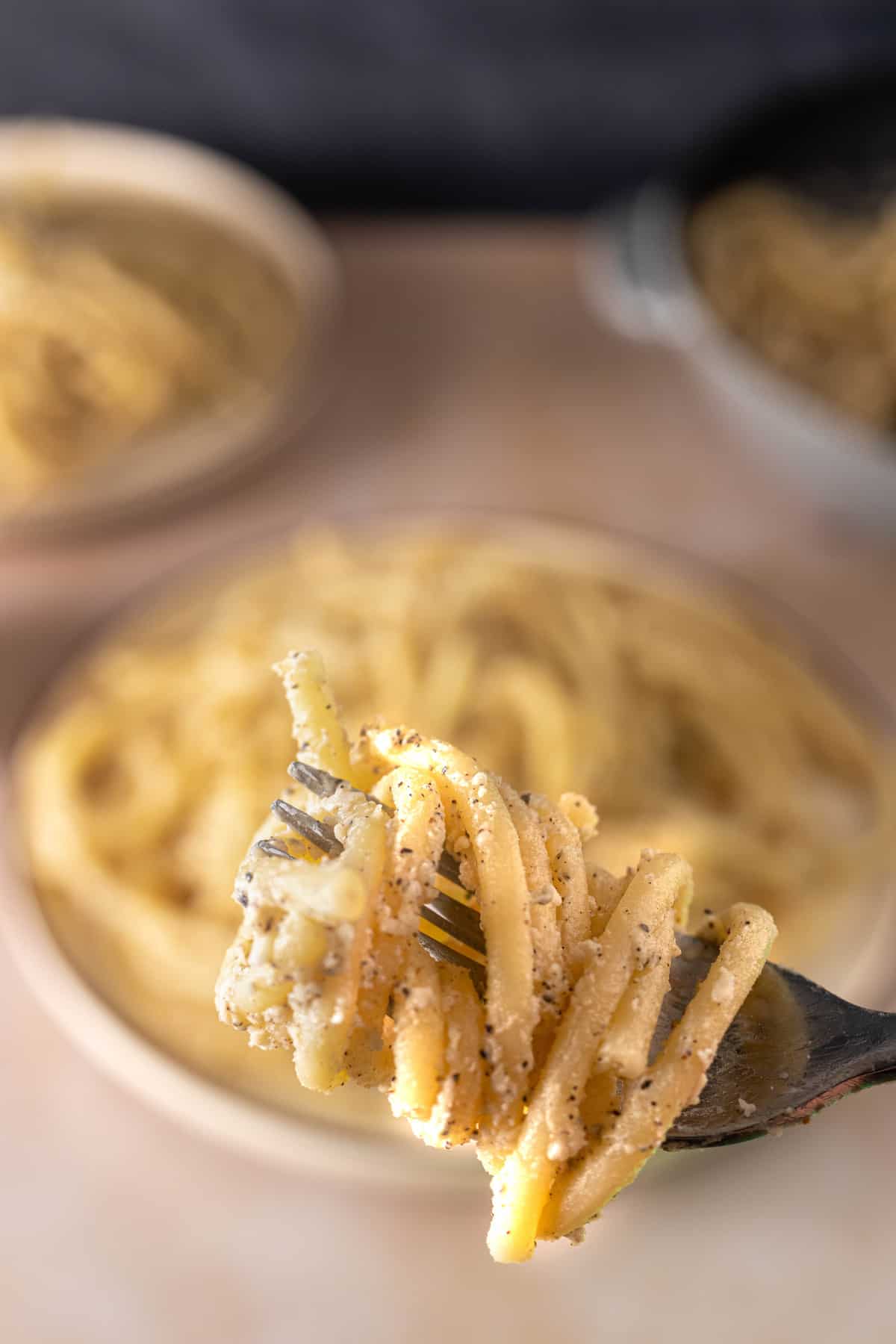




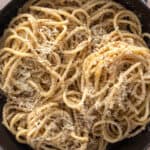








Delish! So simple and understated yet elegant and freaking tasty! I loved your tip to whir together the cheese and pasta water -- that was genuis1
I can't believe this recipe only has 3 ingredients. I made this last night for dinner and it came out so delicious and flavorful. Thank you!
This is my go to recipe when I need dinner quickly on the table! Ive always been partial to romano over parmesan so it's like this dish was made for me. Easy ingredients and simple instructions!
3 ingredients and it tasted just as awesome the next day as it did freshly made. Perfect for crazy nights.
Ooh, bucatini is my favorite type of pasta! I made this right away after seeing it and just loved how flavorful but super simple it is. Thanks a ton!
Darling, lovely take on a classic dish. A gift of wisdom for you ~ “Pecorino” means the cheese comes from sheep’s milk… “pecore” are sheep in Italian. So, Pecorino Romano is a certain type of hard sheep’s milk cheese. In America, you can find hard cheeses that are called “Romano” but are made from cow’s milk. The traditional Cacio e Peppe is made with Pecorino Romano.
Thanks so much for this recipe, i can't wait to try it soon. I would love to know the name of the restaurant that served it to Anthony Bourdain as I plan to be in Rome very soon. Any other recommendations will be most appreciated.
Thank you Susan - if you don't mind, I'll send you an email with the name 🙂
Help, still getting lumpy cheese! Cheese quality? Water too hot? Not enough starch in the water (even added semolina to the water one time)? Tried the blender trick to no avail. I have no trouble with carbonara, but this recipe is making me think I ought to hand in my knives….
Hi Maxwell - sorry to hear you're getting lumpy cheese. Typically, that's a sign of bad cheese (especially if the blender trick is not working). Are you buying fresh cheese and grating? Or buying pre-grated cheese? The latter tends to have potato starch in it that can get lumpy when mixed with water. One other trick you can try is to use cold water to make the cheese slurry and then add hot water slowly to get the desired consistency. Let me know!
As someone who on pasta night has always only had cheese and noodles due to not handling red sauces well. I tried this today for the first time and it was phenomenal. I found many recipes that added butter or cream but read that it wasn’t authentic to do that, so I continued to look and found this one. Will definitely be saved as a favorite!
I am so glad you loved the recipe! 🙂
Hi! Cacio e Pepe is my favorite food, and I'll be going to Rome next month. Could you share the name??
Have sent you an email!
A longtime cacio e pepe fanatic, I can wholeheartedly say that this recipe was the total package: flavorful, light, and the pepper and cheese worked together nicely - no one flavor overpowered my tastebuds. So many times you find cacio e pepe recipes that claim to be authentic but have runny sauces that are just too creamy. This one was perfect. And best of all, the recipe was simple and straightforward.
Thank you Jordan! Super happy you liked the recipe!